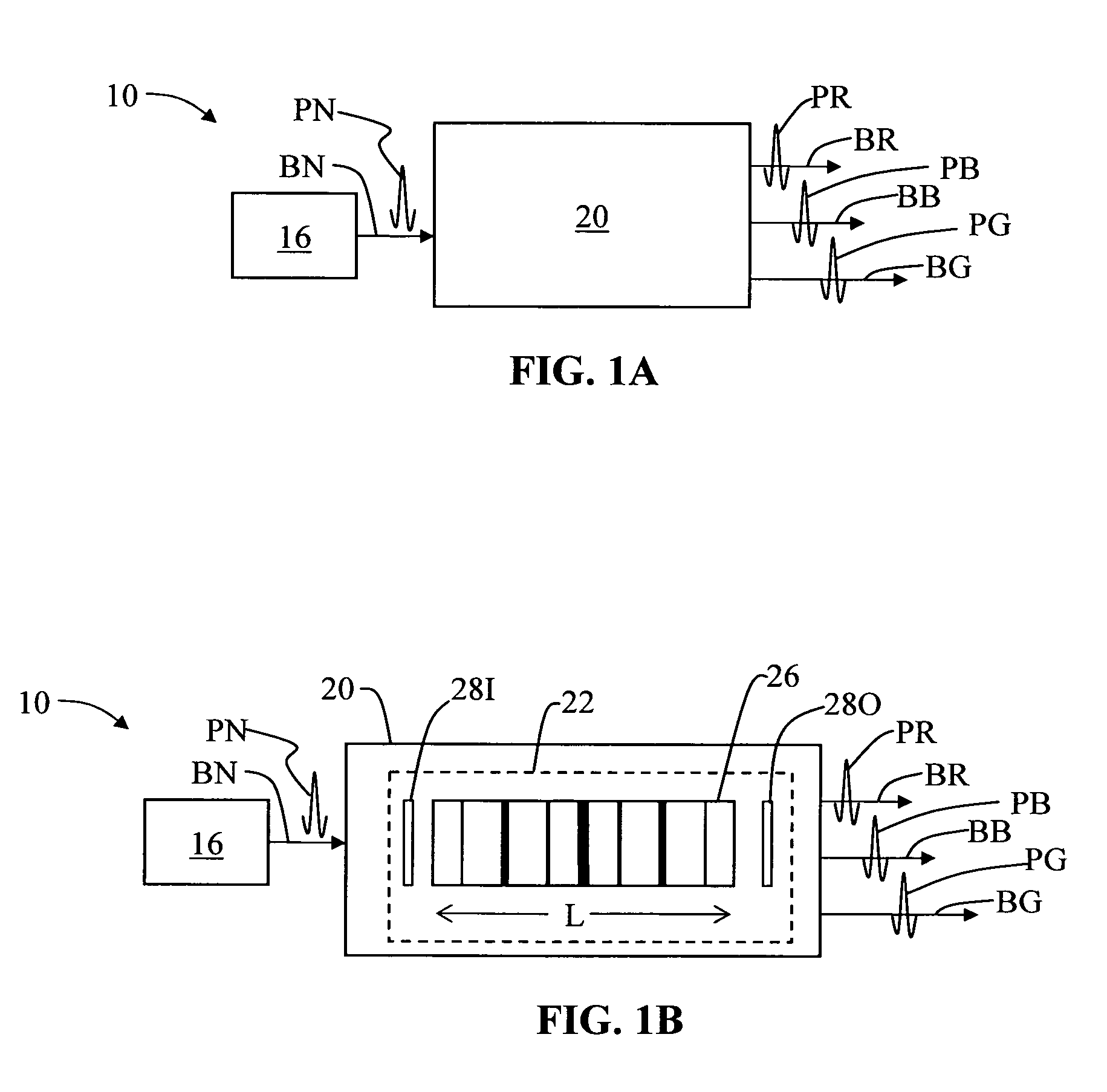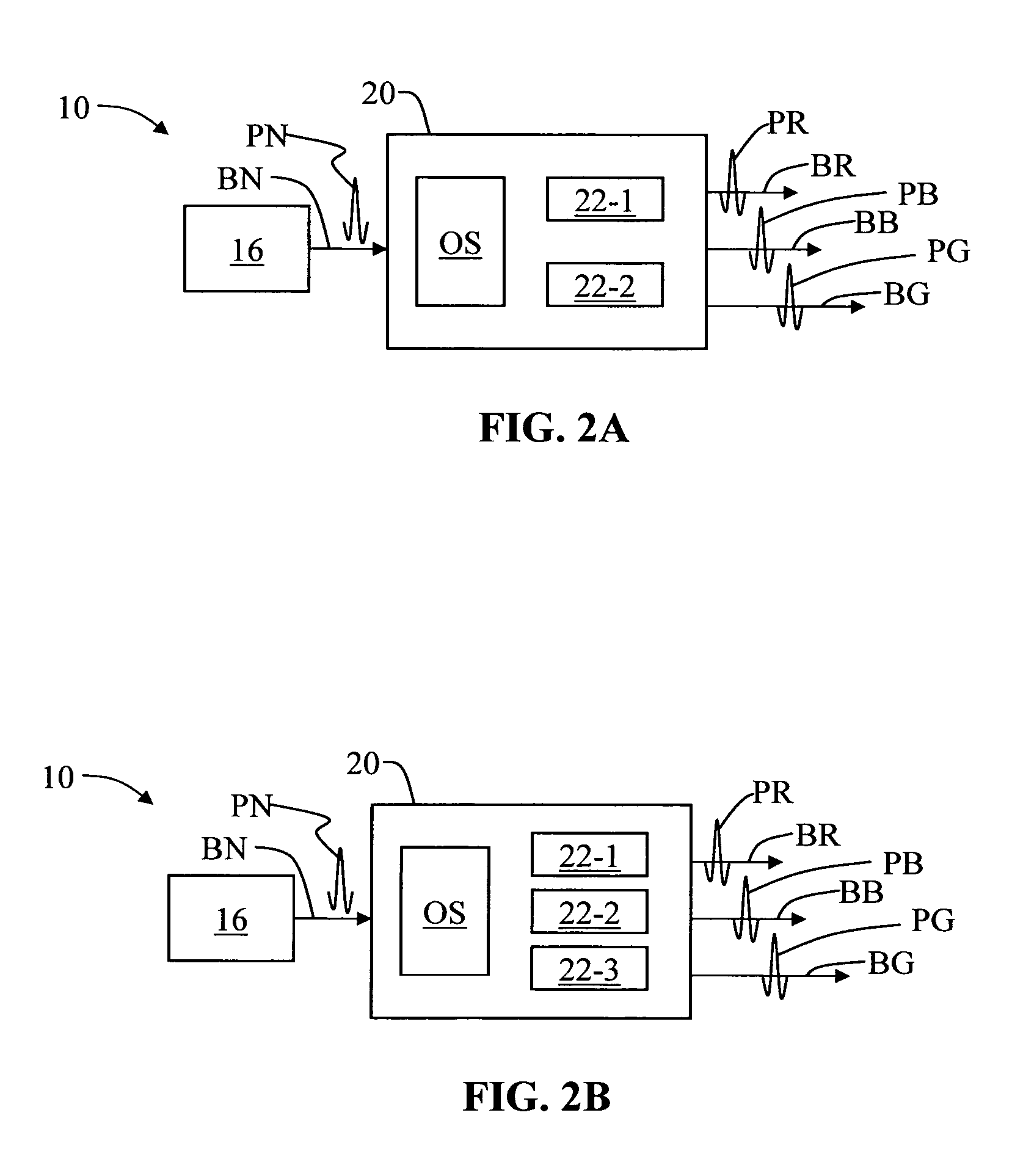Fiber laser red-green-blue (RGB) light source
a fiber laser and red-green-blue technology, applied in the field of fiber lasers, can solve the problems of lack of directionality, low brightness, and non-laser-based rgb sources
- Summary
- Abstract
- Description
- Claims
- Application Information
AI Technical Summary
Benefits of technology
Problems solved by technology
Method used
Image
Examples
generalized embodiment
[0025]FIG. 1A is schematic diagram of a generalized embodiment of a fiber-laser RGB light source (“FL-RGB source”) 10 according to the present invention. FL-RGB source 10 includes a fiber laser 16 optically coupled to a wavelength conversion system 20 having an input end 20I and an output end 20O. Fiber laser 16 outputs a light beam BN having a near-infrared (NIR) wavelength λN. In an example embodiment, NIR light beam BN has a wavelength λN=1036 nm. Also in an example embodiment, light beam BN is made up of NIR light pulses PN (i.e., in the case where fiber laser 16 is a pulsed light source). Example embodiments of fiber laser 16 are discussed in greater detail below.
[0026]Wavelength conversion system 20 is adapted to receive at input end 20I NIR light beam BN from fiber laser 16 and generate therefrom red (λR), green (λG) and blue (λB) output beams BR, BG and BB, respectively, at output end 20O. In an example embodiment, only light originating from NIR output beam BN is used to fo...
example single
Crystal Embodiment
[0028]FIG. 1B is a schematic diagram of an example embodiment of a “single crystal” FL-RGB source 10, wherein wavelength conversion system 20 includes a single NLO unit 22. In an example embodiment, NLO unit 22 includes a single crystal, and in particular consists of an optical parametric oscillator (OPO) having a single periodically poled crystal 26 surrounded at its input and output ends by respective input and output end-mirrors 28I and 28O. Crystal 26 has a poling pattern that contains three poling spatial periods that result in the generation of RGB wavelengths λR, λG and λB, in analogy to a time signal being a sum of three sinusoidal time signals. Also generated in the non-linear optical process in the OPO is mid-infrared (MIR) light of wavelength λM. In an example embodiment, λM=3284 nm.
[0029]In this single-crystal example embodiment, input end-mirror 28I mirror is antireflection (AR) coated at λN (e.g., λN=1036 nm) and high-reflection (HR) coated at λR, λG,...
example two
Crystal Embodiment
[0031]FIG. 2A is a schematic diagram illustrating an example embodiment of a “two crystal” FL-RGB source 10, wherein wavelength conversion system 20 includes an optical system OS and two non-linear optical (NLO) units 22-1 and 22-2. The two NLO units 22-1 and 22-2 are operably arranged relative to optical system OS to receive NIR light beam BN and generate therefrom red, green and blue output beams BR, BG and BB made up of respective light pulses PR, PG and PB. In an example embodiment, optical system OS is configured relative to the first and second NLO units 22-1 and 22-2 so as to provide an optical path over which only light originating from NIR output beam BN is used to form the red-, green- and blue-wavelength light beams BR, BG and BB. That is to say, FL-RGB source 10 does not utilize any other light source besides that from fiber laser 16 to create light beams BR, BG and BB.
[0032]FIG. 3A is a more detailed schematic diagram illustrating an example embodiment...
PUM
| Property | Measurement | Unit |
|---|---|---|
| NIR wavelength | aaaaa | aaaaa |
| average power PR | aaaaa | aaaaa |
| reflectivity R4 | aaaaa | aaaaa |
Abstract
Description
Claims
Application Information
 Login to View More
Login to View More - R&D
- Intellectual Property
- Life Sciences
- Materials
- Tech Scout
- Unparalleled Data Quality
- Higher Quality Content
- 60% Fewer Hallucinations
Browse by: Latest US Patents, China's latest patents, Technical Efficacy Thesaurus, Application Domain, Technology Topic, Popular Technical Reports.
© 2025 PatSnap. All rights reserved.Legal|Privacy policy|Modern Slavery Act Transparency Statement|Sitemap|About US| Contact US: help@patsnap.com



